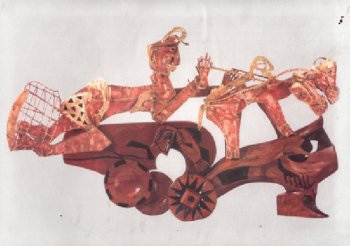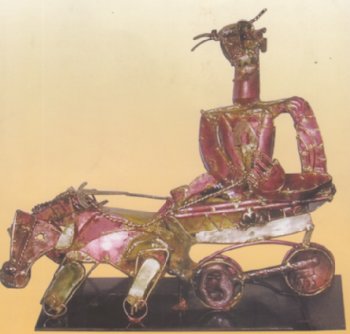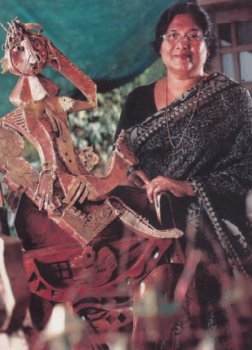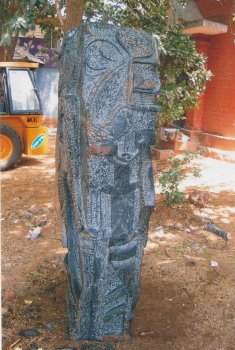Narthaki

News

Info

Featured

 |
  |
Alone and on the move - Padma Jayaraj, Thrissur e-mail: padmajayaraj@gmail.com April 14, 2012 It was a hot summer day in Palghat, Kerala. Heat waves radiated from the Western Ghats. But secure in a glade, forgetful of the world around, a bunch of sculptors were immersed in their work. Eight sculptors, cutting across India were contributing their work to the first Sculpture Park in the country. The lone woman among them was overseeing a crane putting her art work in proper position on the ground. A granite pillar with carvings on 4 sides reminds you of a pillar in an ancient temple in south India If Anila Jacob is occupied, Mr. Jacob is ready to entertain. He pulls out testimonials, photographs of her works, brochures. He talks about the years past that brought her fame and recognition. He recalls how KCS Panikar, the Principal of the College of Art, Madras, interviewed him prior to marriage making him promise that Anila would continue her artistic career. And he has kept the promise. Anila was a born into a family that loved art, in Kottayam, Kerala. Her grandfather had artistic inclinations. That the family had sent her to learn art in those days speaks of how she was released from hold. And she was the first woman to win many awards in a male dominant field. Inspired by gifted women students who made their marks later in the art scene, Anila remained under the spell of her guide, and guardian, KCS. The stamp of the school 'is still visible in the work of this sculptor who is part of Cholamandal.' Anila Jacob stands out in her chosen field of sculpture winning awards and acclaim both in India and abroad from 1962 onwards. The aesthetics of linear rhythm from India's art heritage flows through her works. Her style emphasizes lines as the main element of art expression. Decorative linearity is a telling ingredient of her carvings. The multitude of decorative squares, triangles, circles, ovals etc., creates an aura of spontaneity that traces her lineage to 'Nativism' as an ideology advocated by the Madras Art Movement initiated by KCS. Anila's sculptures are a mélange of ideas and elements wrought together by a sensibility, unique in expression and interpretation. As a woman she incorporates the concept of physical labor as in Fruit Seller, Fisher Woman and Farmhands empathizing with them in a metonymic extension of her own labor as a carver. For Anila, the figurative is an instinct. Her oeuvre today constitutes a figurative genre in mixed media of metal and wood. She works with copper, brass and bronze with teak or rosewood. Her work has two components: wooden base and upper metal image, both well-knit into a seamless unity. She fuses metal and wood with remarkable fluidity. The artist depicts rural Kerala, in its cadences: human figures riding on animals, travelling in carts or boats. Aquatic creatures like the fish and crocodile make their presence felt. Themes and technique coalesce to make suggestive, floating movement. Her works like The Chase, Cart Ride, the Royal Procession, Journey etc., convey forward motion, in a highly individualistic style. The figure is soaring in motion in Cart Ride; the animal, in The Chase; the wheels propel in the stately Royal Procession. All her works seem to be on life's journey: in motion, or poised for motion.  Cart Ride  The Royal Procession Anila Jacob takes a break. Our conversation veers to why women are less in the field of visual arts while their presence is remarkable in performing arts. It seems to be true, that one can start quite early in life, be it music or dance while identifying a chosen field, a discovery that comes rather late in visual arts. "You need patience, infinite patience before recognition reaches, if at all it reaches. When we began even money was hard to come by," Anila recalled. But Luck has blessed Anila Jacob from birth. She came from such a family that her economic source was perennial; luck blessed her in marriage too. And luck has accompanied her all along giving her recognition and fame. She smiled looking at her husband wistfully. But then her two children chose medicine and went abroad in search of new pastures.... even when they had artistic inclinations. "Maybe social pressure...." She wondered. "But one of my grandchildren is an exceptionally talented one." Perhaps the third generation may follow the genetic map.  Journey We stand before an over-sized granite pillar, carved meticulously for details. This is her second work in granite. The first still stands in Connaught Place, Delhi. Indicative in details, it is a fusion of many things as the title Fusion suggests. The old and the new techniques are fused: figurative in suggestive details, closer to cubism in rendering. Her visual language is quasi abstract.  Anila Jacob  The pillar We walk around the piece, pause, wait patiently; yes, the picture emerges: a woman under a spreading tree. Woman from time immemorial has the function of a tree, a fruit-bearing tree. The other side is Beauty and Bird. A flying bird, with its open beak...does it sing and soar, like her spirit? Stories are what Anila's sculptures tell. The third side depicts a fish seller. Yes, the woman is proficient in the give and take of social life. The last is the crowning picture of the woman's glory - the Horse Rider. Here, the horse turns its head and is at a level with the woman's face, as if acknowledging her mastery. "I had Jhansi Rani in mind, the iconic woman in Indian history....each part has a story to tell and that is what I attempt to do," said the artist. An inspiring piece from a woman sculptor! For me the narrative makes it a single piece, although each has its own identity. If the two sides reveal the nature of the woman, the other two points to her capabilities, and her function in social life. From another angle, it is the story of the woman in India down the millennia. Like Mother Nature she has been the mother from the beginnings. Ages have rolled by, civilization has marched ahead, humanity has entered the era of business. And the woman has been moving towards progress. And whatever are the consequences, 'She is striding out,' like the artist herself, like you and me. I bade them good bye and walked on. The prancing horses lead the way, as if the battle is still to be won. My spirit moves on..., riding, riding, riding.... Padma Jayaraj is a freelance writer and a regular contributor to www.narthaki.com Post your comments Please provide your name and email id along with your comment. All appropriate comments posted with name and email id in the blog will also be featured in the site. |